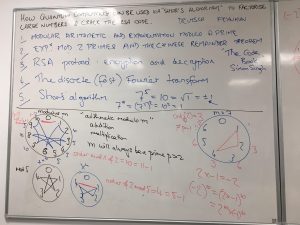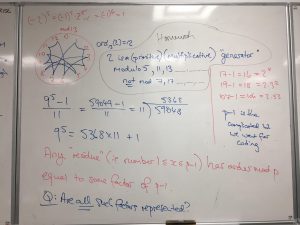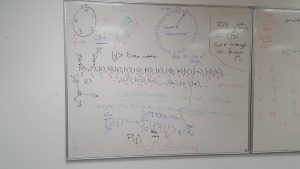
SAMI’s fourth Maths Camp in London was hosted in partnership with Harris Westminster Sixth Form from 22nd to 26th October 2018 for students in Year 12 and Year 13.
What was it all about?
SAMI works around the world to help foster a love and appreciation of maths, and its role in society. The HWSF/SAMI maths camp was a week-long event that brought together students, teachers, lecturers and maths enthusiasts from all walks of life, in shared exploration and discovery of ideas which stretch far beyond the traditional school curriculum. It was also an opportunity to reach out and help those who otherwise might not get such experiences in life.
Resouces
Monday
Here are the questions that Emily Fleming set to answer about the game of Dobble to help us work out how many cards could be in the set. Thanks to Gina at Asmodee for the kind donation of the Dobble sets. The maths behind the Dobble game gets very interesting – here is some interesting further reading. A great book to read for this and much more is How Not to Be Wrong: The Hidden Maths of Everyday Life, by Jordan Ellenberg.
James Handscombe not only gave his school up to the camp, and helped with all the planning and recruitment, but also delivered a wonderful session on the symmetric group S3 via triangles and tangles.
Tony Gardiner, of UKMT fame, gave a great session – The Magic of Multiplication Tables – which showed us a brilliant proof, and emphasised the need for thinking about the structure of answers rather than just the answers. He also encouraged the students to aim far beyond the A-level syllabus and have as many key facts at their fingertips as possible.
Dr Gary McConnell has not only helped plan the camp and provide sponsorship, but has also invited exciting speakers to attend and has given fascinating lectures every day of the week. Below you can see the plan for the week and notes from the first lecture.


We worked on Python to investigate throwing dice, and simulating the game of pig. Instructions are here.
Tuesday
We can highly recommend all of Simon Singh’s books, especially the The Code Book after seeing the Enigma machine today! For those wanting to explore the Vigenere cipher, his excellent website is here.
In Gary’s second session, we worked towards the chinese remainder theorem. Some challenging exercises to try are below:
Professor Bruce Hobbs gave a great talk about the world of Geophysics and how to model the earth and moon in different ways. Students then wrote a program to model the density of the earth’s core using the monte carlo method. The python commands are here.
Professor Alex Paseau gave a very interesting lecture on logic and left us with this article to read.
Wednesday
Professor Kevin Buzzard joined us for the day and led two great sessions. The first had the students finding solutions to a^2-2b^2=+ or -1 (of course not zero as root 2 is irrational!). This led to some fascinating patterns. In the afternoon he introduced us to Lean, a formal proof verification programming language that he is writing. More info on the project is here. Kevin also showed some students a “proof” that all triangles are isosceles … and is awaiting to see who can spot the mistake!
Emily Fleming did a “breakout room” with a 1941 theme with code breaking challenges.
Matthew Boswell challenged students to count to more than 10 on their fingers … we got to 177146 with no bother!
Thursday
Professor Balazs Szendroi managed to explain spherical and hyberbolic geometry starting with just simple reflections, and solving 1/p+1/q+1/r equal to 1, less than, more than one along the way.
Gary gave insights into the Fourier Transform – a topic ususally studied in third year university!
Matthew Boswell posed the following brilliant question:
Can you find a 10 digit number which uses each of the digits 0-9 and has the first two digits divisible by 2, the first three digits divisible by 3, the first four digits divisible by 4 …. etc until the 10 digits divisible by 10.
Jeff Goodman showed Zeller’s algorithm, involving the floor function, which can be used to find which day of the week you were born on.
![]()
d is the day of the month
m is the month you were born in (3 = March, 4=April, …. 13 = January, 14=February)
y is the last two digits of the year (minus one if you were born in January or February)
c is the first two digits of the year
When you get an answer for w, translate it into a day of the week, with Sunday being 1, Monday being 2 etc.
In Ghana you have two names – the day of the week you were born on, and the name your parents give you, so we worked out our Ghanaian names.
Jeff Goodman also gave some tricky codes to break which got extremely competitive. You can try them here.
Dr Gianmarco Bet gave a great session on networks, ending with the following challenges:
Question: You are organizing a party. Since you have been to the SAMI maths camp, instead of buying drinks and snacks, you spend your time thinking about graphs.
- Is it possible to organize a party (you choose the number of guests, but it’s not infinite) where no two persons have the same number of friends?
- (Erdős Theorem) Suppose that there are 6 people present at the party. Prove that there are always three people who already know each other, or there are three people who do not know each other.
Friday
Gary combined all the hard work of the first four lectures into a fascinating description of how RSA can be broken using the power of quantum computers.

Gianmarco carried on the theme of networks and their real life applications – but this time thinking about when there is a randomness built into the graph. We played this great game and analysed the Erdös-Rényi Random Graph.
Chris Clarke tested the students with their statistical knowledge of the world with 9 questions such as:
On average, men aged 25-34 have spent eight years at school. What is the average for women of the same age group?
A – Three years
B – Five years
C – Seven years
In line with other groups of people that have taken a similar quiz, our students did worse than chimpanzees choosing at random!
This session set the scene for Danny Parsons to show the students Gapminder – a fantastic online software that allows you to explore data and trends across the world. Danny highlighted some key surprising trends and allowed students time to discover for themselves.
We were lucky to have a visit from Rudra Jena from Nomura bank. He explained the concept of stocks and then showed – using coin simulation and the power of excel – that much of the behaviour of the stock market is inherently random. Rudra showed the students how to beat the stock market using moving averages (with hindsight of course!).
All of the proceeds from this camp will be used to support our ongoing outreach in mathematics education throughout Africa. We were fortunate to have Francis Torgbor, founder of the Allotey (Ghana) Maths Camp, come to deliver a brilliant session on his research into climatic data. Other special visitors included Adowa Appiah, former volunteer at the Allotey Maths Camp and Rose Mutiso from the Mawazo Institute in Kenya who is sponsoring an all-girls maths camp in partnership with AMI.
Thank you to everyone involved, particularly the students for being so switched on and enthusiastic all week.